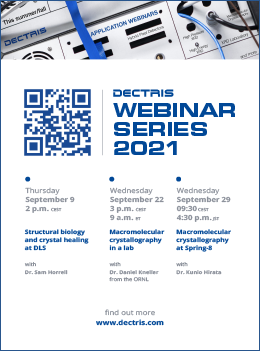


IUCr activities
New Teaching edition of International Tables for Crystallography: Crystallographic symmetry
![Thumbnail [Thumbnail]](https://www.iucr.org/__data/assets/image/0006/151629/te.png)
The Brief Teaching Edition of Volume A of International Tables for Crystallography (IT) was first published in 1985. Edited by Theo Hahn, it found its way into many a classroom or laboratory as a convenient and inexpensive tool for researchers and students. Now in its sixth edition, the publication has a new Editor, Mois I. Aroyo, and – although still a practical size – has dropped the "Brief" from its title. The following description of the contents is extracted from the Editor's Preface.
This Teaching Edition (hereafter referred to as the TE) is the successor to the Brief Teaching Edition of Volume A (which was last revised in 2005), although new material, substantial revisions and reorganisation of the text has resulted in a book that is quite different in structure and content to its predecessor. It focuses on the particular topic of symmetry, owing to its fundamental role in crystallography, and provides a unified and coherent introduction to the symmetry information found in three volumes of International Tables for Crystallography: the basic crystallographic data for the plane and space groups in Volume A (IT A), the symmetry relations between space groups treated in Volume A1 (IT A1) and the subperiodic-group data found in Volume E (IT E). It also introduces the Symmetry Database, which forms part of the online version of International Tables for Crystallography at https://it.iucr.org.
This Teaching Edition is designed for graduate (and postgraduate) students, and young researchers who have some awareness of the basics of symmetry and diffraction and who need to use crystallographic symmetry methods in their work. The TE can thus serve as an interface between elementary crystallography textbooks and the texts in IT A, A1 and E. Sufficient up-to-date and accessible references to further specialized sources are provided for those who need to go deeper into the subject, and to textbooks and basic crystallographic literature that could be helpful for those who need a course in basic crystallography or introduction to the mathematics that is required. The fruitful combination of tables for practical use and a didactic introduction to symmetry makes this TE a handy tool with which researchers and students can familiarize themselves with the use of crystallographic symmetry and its practical applications.
Part 1 of the TE is based on the material of the introductory part of the sixth edition of IT A, with additional explanations and illustrative examples to provide the reader with practical experience in the use of crystallographic symmetry data. The fundamental concepts of group theory, focusing on those properties that are of particular importance for crystallography, are introduced in the first chapter. The matrix formalism, which provides efficient instruments for the analytical description of crystallographic symmetry, is the subject of Chapter 1.2. Chapter 1.3 offers an introduction to the structure of space groups and their various classification schemes, focusing on the classifications into space-group types, geometric crystal classes and Bravais types of lattices. Chapter 1.4 deals with various crystallographic terms and the symbols used to present the symmetry data in the space-group tables of IT A. The purpose of Chapter 1.5 is to provide the mathematical tools needed to work out how crystallographic data are transformed if the coordinate system is changed. Chapter 1.6 offers a detailed presentation of methods for determining the symmetry of single-domain crystals from diffraction data. The tables of general reflection conditions shown in this chapter also include ‘diffraction symbols’ (previously known as ‘extinction symbols’), and four examples of space-group determination from real intensity data are analysed. Chapter 1.7 deals with applications of crystallographic symmetry, including symmetry relations between space groups, as treated in IT A1, and subperiodic groups, as covered in IT E. Possible applications of the subperiodic groups in the description of crystal systems with rod and layer symmetry are discussed. Finally, magnetic groups, including magnetic subperiodic groups and magnetic space groups, are briefly introduced.
The material of Part 2 focuses on the presentation of the tables of crystallographic symmetry data found in Volumes A, A1 and E, including descriptions of the symbols and terms found in the tables and guides for their use. Representative sets of tables of varying complexity are included that will be useful for teaching about crystallographic symmetry. The guide to the space-group tables of Volume A is very similar to that given in Chapter 2.1 of IT A and is complemented by the tables for 7 of the plane groups and 35 of the space groups. In Chapter 2.2, the data for the maximal subgroups and minimal supergroups in IT A1 are described and illustrated using the examples of P3112 (151) and P3121 (152). The guide to the arrangement of the data specifying relations between Wyckoff positions in IT A1 uses the tables of P63/mmc (194) and Cmcm (63) as examples. The subperiodic-group tables in IT E are described in Chapter 2.3 and are illustrated by the tables of the rod group 𝓅mc21 (No. 17), and of the layer groups p21/b11 (No. 17) and pbam (No. 44). Finally, Chapter 2.4 gives a brief description of the Symmetry Database, which provides online access to data for the crystallographic space and point groups that extend and enhance the symmetry information given in the printed editions of IT A and A1.
Commentary by Carolyn P. Brock, Editor-in-chief, International TablesThe first edition of the Brief teaching edition of Volume A: Space-group symmetry (the BTE) in 1985 contained complete descriptions of the 17 plane groups, 24 selected space-group examples, and those basic text sections of Volume A necessary for the understanding and handling of space groups (Parts 1, 2, 3 and 5). By simply copying parts of Vol. A the cost of the BTE was kept low for the benefit of students. Subsequent editions were unchanged except for revisions made to Vol. A (e.g. the change of group Cmca to Cmce). While the low cost and small size of the BTE appealed to students and their teachers, many found the expertise needed to understand its text daunting. When Mois Aroyo became Editor of Vol. A he began to rethink the BTE, a process that lasted at least 13 years. The new Teaching Edition of 2021 (the TE) is still brief and low-cost, but it differs so much from the BTE that it is a new effort rather than a revision. While working on the TE Mois participated as a lecturer/tutor in dozens of schools organized by the IUCr Commission on Mathematical and Theoretical Crystallography, where he gained an excellent understanding of students’ needs. He then recruited some new authors and exercised a firm, but always very tactful, editorial hand. The result is a wonderful book that assumes much less prior knowledge and also introduces students to topics (e.g. magnetic groups, subperiodic groups, sub- and supergroup relationships, space-group determination by electron diffraction) that show crystallographic symmetry to be a field that is still under development. The TE also introduces the Symmetry Database, an electronic resource that is part of International Tables. A few pages of the TE are printed in color because the illustrations would have been difficult to understand in grayscale. While no actual diagram of a magnetic space group is included in the TE, Danny Litvin’s very large compilation of the magnetic space groups (ISBN 978-0-9553602-2-0; 106 MB) is freely available via the IUCr website. It is difficult to thank Mois Aroyo adequately for his many years of work on this very successful project. |
The 250-page paperback (ISBN 978-0-470-97422-3) is available from Wiley at a cost of USD 40.00/EUR 33.90/GBP 29.99 [excluding taxes (if applicable) and postage]. Bulk discounts may be available; please contact Wiley's Corporate and Custom Sales team.
Copyright © - All Rights Reserved - International Union of Crystallography







